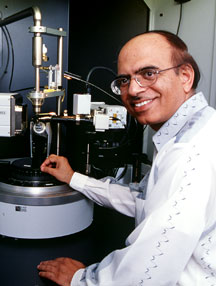

 |  |
TSRI Facility Shoots for Crystal-Clear ResultsBy Mika Ono
Eight large crates marked “fragile” and "attention Raj Chadha" arrived recently at The Scripps Research Institute (TSRI). They contained what would soon be a boon to many scientists on campus: a brand new x-ray crystallography machine. "This instrument is fast," says Raj Chadha, who single-handedly runs the X-Ray Crystallographic Facility, located on the ground floor of the Beckman Building. "Data collection to determine crystal structure takes five to ten hours instead of three to seven days." The equipment, a Bruker SMART APEX, has been put to use by the TSRI researchers—mostly chemists—who work with small molecules. Despite faster and easier methods to ascertain structure, such as NMR and mass spectrometry, x-ray crystallography still sets the standard for reliability in the field, producing results that are rarely challenged. Steven Brunette, research associate in the Boger lab, is one of those on campus who has reaped the benefits of the new technology. "I got results much faster than with the old instrument—in one day versus one week," he says. "Raj was also able to solve a structure [a non-natural alkylation subunit of anti-tumor antibiotic CC-1065] he couldn’t before. If those aren’t two big pluses for the new machine, I don’t know what are." Purchased with a grant to Professors Julius Rebek, Jr., and Reza Ghadiri, the x-ray crystallography machine sports a 4K CCD detector—cutting-edge technology in such equipment. Although the older Rigaku AFC6S machine is now used only occasionally, it has been kept at the facility, serving as a back-up system as well as the instrument of choice for absolute configuration studies (which give the relative orientation of atoms in a molecule). Of Surprises and SolutionsChadha solves some 50 structures a year for TSRI scientists. Most of the time the sample turns out to be what the researchers who synthesized it predicted. But, once in a while, there is a surprise. "When my studies indicate a different substance than expected, the researchers are forced to think about their reactions in a new way," comments Chadha. "My knowledge of chemistry comes in handy when I need to explain why we have one compound and not another." Chadha’s knowledge and experience also come in handy when working with challenging structures. According to Chadha, having good crystals and choosing the best crystal from the flask are essential in difficult cases. One especially memorable structure he determined came from the Ghadiri lab. The sample consisted of nanotubes with free water molecules whose positions were not defined. Other projects Chadha has worked on in his nine years at Scripps stand out for non-technical reasons. He remembers well the project brought to him by the Nicolaou group: ascertaining the structures of taxol—now approved by the Food and Drug Administration for treatment of ovarian cancer—and its precursors. In addition to solving structures, Chadha writes reports, archives data and submits findings to the Cambridge Crystallography Database, the central depository for such information. He also conducts elemental analysis (a technique used to determine the amount of carbon, hydrogen and nitrogen in a sample), maintains the equipment, and referees the journals "Inorganica Chimica Acta" and "Journal of Chemical Crystallography." His other duties help balance the cyclical nature of the x-ray crystallography itself. "I can tell when the researchers have been productive," Chadha laughs. "My workload has picked up again now it’s March. The beginning of the year is slow as a result of Christmas vacations."
|
 Director of the X-Ray Crystallographic Facility Raj Chadha solves some 50 structures a year for TSRI scientists |
|